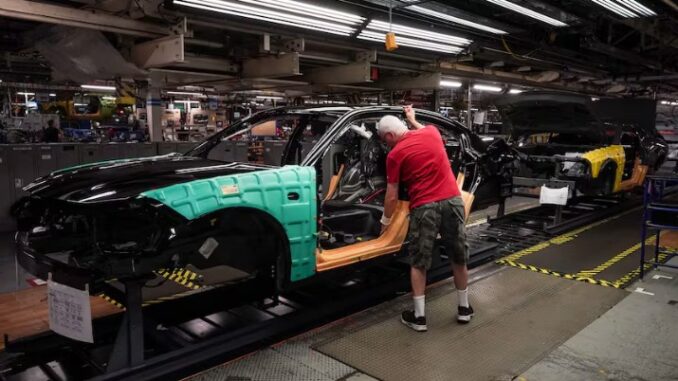
In a bold pivot that underscores the intensifying North American trade tensions, Stellantis NV has announced a massive $13 billion investment in its U.S. manufacturing operations, redirecting production of the Jeep Compass from its planned Ontario hub to a revitalized Illinois facility.
This move, revealed on October 14, 2025, is set to boost U.S. vehicle output by 50% over the next four years while adding over 5,000 American jobs—but at the potential expense of thousands of Canadian positions, igniting backlash from unions and political leaders.
The decision marks a significant U-turn for the automaker, formerly known as Fiat Chrysler Automobiles, which had committed in 2023 to retooling the Brampton Assembly Plant in Ontario for the next-generation Jeep Compass, including both electric and gas-powered variants.
Production was slated to resume in the fourth quarter of 2025, but Stellantis paused retooling in February amid broader industry headwinds.
Now, the Compass—and potentially the Jeep Cherokee—will roll off the lines at the Belvidere Assembly Plant in Illinois, a site shuttered since 2023 but now earmarked for a $600 million revival that could create 3,300 jobs by 2027.
A Strategic Response to Tariff Turbulence
At the heart of Stellantis’ course correction lies the escalating trade war rhetoric from the Trump administration. U.S. President Donald Trump has imposed tariffs on Canadian and Mexican vehicle imports this year, aiming to repatriate manufacturing and curb what he calls unfair competition.
U.S. Commerce Secretary Howard Lutnick recently amplified these pressures, declaring the administration’s intent to “end vehicle assembly in Canada and move those jobs south.”
For Stellantis, these policies translate to an estimated €1.5 billion in added costs for vehicles built north of the border, prompting a reevaluation of its global footprint.
“This is the single largest investment in the company’s history,” Stellantis CEO Carlos Tavares stated during the announcement, framing it as a bid to enhance “domestic manufacturing footprint” and profitability in North America.
The funds will fuel expansions across four states—Illinois, Ohio, Michigan, and Indiana—including the reopening of two assembly plants and the launch of five new models alongside 19 refreshed ones.
While the shift safeguards Stellantis from tariff bites on U.S.-bound exports, it exposes the fragility of cross-border supply chains in an era of protectionism.
Canadian Prime Minister Mark Carney, responding swiftly, attributed the decision directly to “current U.S. tariffs and potential future U.S. trade actions,” calling for stability through the upcoming review of the Canada-United States-Mexico Agreement (CUSMA).
Ontario Premier Doug Ford echoed this frustration, voicing “sharp disappointment” after direct talks with Stellantis executives and pledging provincial support for displaced workers via $20 million in retraining programs.
Got Questions on investing in oil and gas? Or do you have a Tax Burden in 2025?
Fallout in Brampton: Jobs on the Line
The human cost is stark in Brampton, where the assembly plant has idled for over 18 months, leaving more than 3,000 Unifor-represented workers in layoff limbo.
Unifor National President Lana Payne decried the shift as “auto jobs… being sacrificed on the Trump altar,” urging Ottawa to wield “every lever of influence” to retain investment in Canada.
“Stellantis cannot be allowed to renege on its commitments to Canadian workers,” she added, positioning the Brampton plant’s salvation as a national imperative.
Brampton Mayor Patrick Brown called the news “deeply disappointing,” highlighting the ripple effects on local families and the economy.
The Canadian Automotive Parts Manufacturers Association (APMA) shares these worries, with CEO Flavio Volpe warning that without a committed vehicle program for Brampton, downstream suppliers, toolmakers, and ancillary industries could face cascading losses.
Stellantis, however, insists Canada remains integral to its strategy. Spokesperson LouAnn Gosselin emphasized the company’s century-plus legacy in the country, noting a commitment to add a third shift at the Windsor Assembly Plant for surging demand on the Chrysler Pacifica minivan and new SIXPACK-powered Dodge Charger models.
“We have plans for Brampton and will share them upon further discussions with the Canadian government,” Gosselin stated, hinting at forthcoming announcements but offering no specifics.
Broader Implications for North American Auto
This reshuffle isn’t isolated; it’s symptomatic of a Detroit Three scramble under tariff duress. Rival Ford Motor Co. seized on the news to press the federal government for stronger safeguards, citing Ontario’s 157,000 auto jobs at stake.
Industry observers like Octane magazine editor Tom Venetis argue the “changing tariff regime” forces such adaptations, potentially accelerating a southward migration of assembly lines.
For Stellantis, the bet is on U.S.-centric growth to offset global challenges, including EV transitions and softening demand. Yet, as Unifor calls for a “coordinated Team Canada approach,” the saga highlights the high-stakes chess game of modern manufacturing—where policy trumps promises, and borders redraw economic destinies.
As negotiations unfold, all eyes turn to whether Canadian leverage can claw back commitments, or if this signals the start of a broader exodus. For now, Brampton workers wait, and the Jeep faithful ponder if their next Compass will bear an Illinois stamp.
Got Questions on investing in oil and gas? Or do you have a Tax Burden in 2025?
Crude Oil, LNG, Jet Fuel price quote
ENB Top News
ENB
Energy Dashboard
ENB Podcast
ENB Substack







